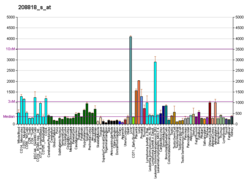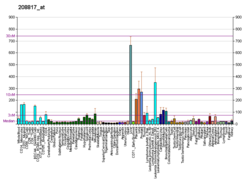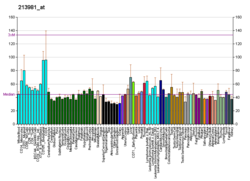카테콜-O-메틸전달효소
Catechol-O-methyltransferase| 컴트 | |||||||||||||||||||||||||||||||||||||||||||||||||||
|---|---|---|---|---|---|---|---|---|---|---|---|---|---|---|---|---|---|---|---|---|---|---|---|---|---|---|---|---|---|---|---|---|---|---|---|---|---|---|---|---|---|---|---|---|---|---|---|---|---|---|---|
 | |||||||||||||||||||||||||||||||||||||||||||||||||||
| |||||||||||||||||||||||||||||||||||||||||||||||||||
| 식별자 | |||||||||||||||||||||||||||||||||||||||||||||||||||
| 에일리어스 | COMT, HEL-S-98n, 카테콜-O-메틸전달효소 | ||||||||||||||||||||||||||||||||||||||||||||||||||
| 외부 ID | OMIM : 116790 MGI : 88470 HomoloGene : 30982 GenCard : COMT | ||||||||||||||||||||||||||||||||||||||||||||||||||
| |||||||||||||||||||||||||||||||||||||||||||||||||||
| |||||||||||||||||||||||||||||||||||||||||||||||||||
| |||||||||||||||||||||||||||||||||||||||||||||||||||
| |||||||||||||||||||||||||||||||||||||||||||||||||||
| |||||||||||||||||||||||||||||||||||||||||||||||||||
| 위키데이터 | |||||||||||||||||||||||||||||||||||||||||||||||||||
| |||||||||||||||||||||||||||||||||||||||||||||||||||
| 카테콜-O-메틸전달효소 | |||||||||
|---|---|---|---|---|---|---|---|---|---|
| 식별자 | |||||||||
| EC 번호 | 2.1.1.6 | ||||||||
| CAS 번호 | 9012-25-3 | ||||||||
| 데이터베이스 | |||||||||
| 인텐츠 | IntEnz 뷰 | ||||||||
| 브렌다 | 브렌다 엔트리 | ||||||||
| ExPASy | NiceZyme 뷰 | ||||||||
| 케그 | KEGG 엔트리 | ||||||||
| 메타사이크 | 대사 경로 | ||||||||
| 프라이머리 | 프로필 | ||||||||
| PDB 구조 | RCSB PDB PDBe PDBum | ||||||||
| 진 온톨로지 | AmiGO / QuickGO | ||||||||
| |||||||||
카테콜-O-메틸전달효소(COMT; EC 2.1.1.6)는 카테콜아민(도파민, 에피네프린, 노르에피네프린 등의 신경전달물질), 카테콜에스트로겐 및 카테콜 [7]구조를 가진 다양한 약물과 물질을 분해하는 효소 중 하나이다.사람의 경우 카테콜-O-메틸전달효소 단백질은 COMT [8]유전자에 의해 코드된다.COMT는 용해성 단형(S-COMT)과 막결합 장형(MB-COMT)의 두 가지 동형식이 생성된다.카테콜아민의 조절이 여러 의료 조건에서 손상됨에 따라, 몇몇 약품들은 COMT의 활성을 변화시키고, 따라서 [9]카테콜아민의 가용성을 변화시키는 것을 목표로 한다.COMT는 1957년 [10]생화학자인 줄리어스 액셀로드에 의해 처음 발견되었다.
기능.
카테콜-O-메틸전달효소는 카테콜아민 신경전달물질(도파민, 에피네프린 및 노르에피네프린)의 불활성화에 관여한다.이 효소는 S-아데노실 메티오닌(SAM)에 의해 기증된 카테콜아민에 메틸기를 도입한다.카테콜에스트로겐 및 카테콜 함유 플라보노이드와 같이 카테콜 구조를 가진 화합물은 COMT의 기질이다.
카테콜아민의 전구체인 레보도파는 COMT의 중요한 기질이다.엔타카폰과 같은 COMT 억제제는 COMT로부터 레보도파를 구하고 레보도파의 [11]작용을 연장시킨다.엔타카폰은 레보도파 요법의 보조약으로 널리 사용된다.도파탈카르복실화효소 억제제(카르비도파 또는 벤세라지드)를 투여하면 레보도파가 최적으로 저장된다.이 트리플 요법은 파킨슨병 치료의 표준이 되고 있다.
COMT에 의해 촉매되는 특정 반응은 다음과 같습니다.
- 도파민 → 3-메톡시틸라민
- DOPAC → HVA(호모바닐산)
- 노르에피네프린 → 노르메타네프린
- 에피네프린 → 메타네프린
- 디히드록시페닐에틸렌글리콜(DOPEG)→메톡시히드록시페닐글리콜(MOPEG)
- 3,4-디히드록시만델산(DOMA) → 바닐릴만델산(VMA)
뇌에서 COMT 의존성 도파민 분해는 전전두피질과 [12][13][14][15]같이 시냅스 전 도파민 트랜스포터(DAT)의 발현이 낮은 뇌 영역에서 특히 중요하다(PFC에서는 도파민은 시냅스 전 노르에피네프린 트랜스포터(NET)에 의해 제거되고 모노아민 산화효소에 의해 분해된다).[16]CNS에서 [17][18][19]막결합 COMT의 우세성과 배향에 대한 논란이 있다. 즉, 이 COMT 과정이 시냅스 후 뉴런과 글리아에서 세포내 활성인지, 또는 시냅스 외 도파민에 세포외적으로 작용하는지 여부이다.
수용성 COMT는 세포외 COMT가 [20]: 210 말초보다 CNS에서 덜 중요한 역할을 하지만 세포외에서도 발견될 수 있다.신경세포에서의 중요성에도 불구하고 COMT는 사실 [20]: 135 간에서 주로 발현된다.
인간의 유전학
COMT 단백질은 COMT 유전자에 의해 코드화되어 있습니다.이 유전자는 대립 유전자와 관련되어 있습니다.가장 잘 연구된 것은 ValMet이다158.[15]다른 예로는 성격 [21]특성, 항우울제 [22]약물에 대한 반응, 알츠하이머 [23]질환과 관련된 정신질환 위험에 대해 연구된 rs737865와 rs165599가 있다.COMT는 정신분열증의 병인에 잠재적 유전자로 연구되어 왔지만 메타분석자들은 정신분열증의 위험과 ValMet을 [25][26][27]포함한158 많은 다형성 사이에 [24]연관성을 발견하지 못했다.
발메트158 다형
카테콜-O-메틸전달효소 유전자의 기능성 단일뉴클레오티드 다형성(일반적인 정상변형)은 위치 158([15]ValMet158) rs4680에서 발린에서 메티오닌으로의 돌연변이를 일으킨다.체외에서 호모 접합 Val 변이체는 메티오닌의 [22]최대 4배 속도로 도파민을 대사한다.그러나 생체 내 Met 변이체는 [28]뇌에서 과압되어 기능성 효소 [29]활성의 40% 감소(75% 감소가 아니라)를 초래한다.Met 대립 유전자에 대한 이화율이 낮을수록 신경전달물질 방출 후 시냅스 도파민 수치가 높아져 궁극적으로 시냅스 후 뉴런의 도파민 작동성 자극을 증가시킨다.전전두엽 도파민 분해에서 COMT의 선호적인 역할을 감안할 때 ValMet158 다형은 전두엽의 도파민 시그널링을 변조함으로써 인지에 영향을 미치는 것으로 생각된다.
유전자 변형은 집합 이동, 반응 억제, 추상적 사고, 규칙 또는 작업 [30][unreliable medical source][31][unreliable medical source][32][unreliable medical source]구조의 획득과 같은 실행 기능과 광범위하게 관련된 인지 작업에 영향을 미치는 것으로 나타났다.
유사한 인지 과제, 전두엽, 신경전달물질 도파민에 대한 비교 효과는 모두 정신분열증과 [33][34]관련이 있다.COMT의 유전적인 변종은 누군가가 나중에 [35][unreliable medical source]정신분열증에 걸리게 할 수 있는 유전적 요인 중 하나라고 제안되었다.보다 최근의 연구는 이 유전자와 정신분열증 [36][unreliable medical source]발달에 대한 대마초의 일시적인 영향 사이의 제안된 연관성에 대해 의문을 제기한다.
비동명 단일핵산 다형성 rs4680은 정신분열증 [37]피험자의 양성 및 음성증후군 척도(PANS)의 우울인자와 감정의 효율과 관련이 있는 것으로 밝혀졌다.COMT 유전자의 대립 유전자 변이가 전전두와 변연계 영역 간의 상호작용에 영향을 미치는 것으로 보이기 때문에 감정 처리에도 관련이 있다는 것이 점차 인식되고 있다.런던 킹스칼리지 정신의학연구소 신경생물학부에서 실시된 연구는 조울증 환자와 [38][unreliable medical source]그 친척 모두에게 COMT의 효과를 입증했지만, 지금까지 이러한 연구 결과는 재현되지 않았다.
COMT ValMet158 다형성은 감정 처리에도 [38][unreliable medical source][39][unreliable medical source]다방성 효과가 있다.게다가, 다형성은 주관적인 웰빙의 등급에 영향을 미치는 것으로 나타났다.621명의 여성을 경험 샘플 모니터링으로 측정했는데, 이는 비프 시계에 대한 반응으로 기분 평가와 유사하다. met/met 형태는 다양한 일상 사건에서 웰빙의 주관적인 정신적 감각을 두 배로 나타낸다.Met 대립 유전자의 [40][unreliable medical source]수에 따라 보상을 경험할 수 있는 능력이 높아집니다.또한, 다른 유전자형의 효과는 더 기분 좋게 느껴지는 사건에서 더 컸다.유전자형 조절의 효과 크기는 상당히 컸다.Val/Val 유전자형을 가진 피험자는 '매우 유쾌한 사건'에서 주관적인 행복감을 거의 비슷하게 발생시켰다.피질 도파민 톤에 기능적인 영향을 미치는 유전자 변이는 일상생활의 [40]흐름에 대한 보상 경험에 강한 영향을 미친다.한 연구에서 met/met 표현형을 가진 참가자들은 매우 쾌적하거나 유쾌한 [40][unreliable medical source]사건 이후에 Val/Val 표현형을 가진 참가자들보다 진폭에서 두 배 높은 양의 영향을 증가시켰다.
한 리뷰는 Val/Val을 가진 사람들이 Met/Met 대립 유전자를[41] 가진 사람들보다 더 외향적이고, 더 신규성을 추구하며, 덜 신경질적인 경향이 있다는 것을 발견했다.
턱관절 기능 장애
TMD는 고전적인 유전 질환으로 보이지 않지만, COMT를 코드하는 유전자의 변이가 [42]일생 동안 TMD가 발병하는 소인의 유전의 원인이 되는 것으로 제안되었습니다.
명명법
COMT는 이 효소를 코드하는 유전자에 붙여진 이름입니다.이름에 있는 O는 산소를 의미하지 정형외과를 의미하지 않습니다.
COMT 억제제
COMT 억제제는 엔타카폰, 톨카폰, 오피카폰 및 니테카폰을 포함한다.니테카폰을 제외한 모든 것이 파킨슨병 [43]치료에 사용된다.간 독성과 관련된 소화기 장애의 위험은 톨카폰의 [44]사용을 제한한다.
「 」를 참조해 주세요.
기타 이미지
레퍼런스
- ^ a b c GRCh38: 앙상블 릴리즈 89: ENSG000093010 - 앙상블, 2017년 5월
- ^ a b c GRCm38: 앙상블 릴리즈 89: ENSMUSG000000326 - 앙상블, 2017년 5월
- ^ "Human PubMed Reference:". National Center for Biotechnology Information, U.S. National Library of Medicine.
- ^ "Mouse PubMed Reference:". National Center for Biotechnology Information, U.S. National Library of Medicine.
- ^ Flower R, Rang HP, Dale MM, Ritter JM (2007). "Figure 11-4". Rang & Dale's pharmacology (6th ed.). Edinburgh: Churchill Livingstone. ISBN 978-0-443-06911-6.
- ^ Rang HP, Dale MM, Ritter JM, Flower RJ, Henderson G (2011). "Figure 14.4". Rang & Dale's Pharmacology. Student consult (7th ed.). Elsevier Health Sciences. ISBN 978-0-7020-4504-2.
- ^ "Test ID: COMT: Catechol-O-Methyltransferase Genotype". mayomedicallaboratories.com. Mayo Clinic: Mayo Medical Laboratories. Archived from the original on September 18, 2008. Retrieved November 16, 2016.
- ^ Grossman MH, Emanuel BS, Budarf ML (April 1992). "Chromosomal mapping of the human catechol-O-methyltransferase gene to 22q11.1----q11.2". Genomics. 12 (4): 822–825. doi:10.1016/0888-7543(92)90316-K. PMID 1572656.
- ^ Tai CH, Wu RM (February 2002). "catechol-O-methyltransferase and Parkinson's disease". Acta Medica Okayama. 56 (1): 1–6. doi:10.18926/AMO/31725. PMID 11873938.
- ^ Axelrod J (August 1957). "O-methylation of epinephrine and other catechols in vitro and in vivo". Science. 126 (3270): 400–401. Bibcode:1957Sci...126..400A. doi:10.1126/science.126.3270.400. PMID 13467217.
- ^ Ruottinen HM, Rinne UK (November 1998). "COMT inhibition in the treatment of Parkinson's disease". Journal of Neurology. 245 (11 Suppl 3): P25–P34. doi:10.1007/PL00007743. PMID 9808337. S2CID 26793445.
Goetz CG (May 1998). "Influence of COMT inhibition on levodopa pharmacology and therapy". Neurology. 50 (5 Suppl 5): S26–S30. doi:10.1212/WNL.50.5_Suppl_5.S26. PMID 9591519. S2CID 32448444. - ^ Brodal P (2016). "Chapter 5: Neurotransmitters and their receptors". The Central Nervous System. Oxford University Press. p. 75. ISBN 978-0-19-022896-5.
- ^ Scheggia D, Sannino S, Scattoni ML, Papaleo F (May 2012). "COMT as a drug target for cognitive functions and dysfunctions". CNS & Neurological Disorders Drug Targets. 11 (3): 209–221. doi:10.2174/187152712800672481. PMID 22483296.
- ^ Diaz-Asper CM, Weinberger DR, Goldberg TE (January 2006). "catechol-O-methyltransferase polymorphisms and some implications for cognitive therapeutics". NeuroRx. 3 (1): 97–105. doi:10.1016/j.nurx.2005.12.010. PMC 3593358. PMID 16490416.
- ^ a b c Schacht JP (October 2016). "COMT val158met moderation of dopaminergic drug effects on cognitive function: a critical review". The Pharmacogenomics Journal. 16 (5): 430–438. doi:10.1038/tpj.2016.43. PMC 5028240. PMID 27241058.
- ^ Juarez B, Han MH (September 2016). "Diversity of Dopaminergic Neural Circuits in Response to Drug Exposure". Neuropsychopharmacology. 41 (10): 2424–2446. doi:10.1038/npp.2016.32. PMC 4987841. PMID 26934955.
- ^ Nissinen E, ed. (2010). Basic Aspects of Catechol-O-Methyltransferase and the Clinical Applications of its Inhibitors. Academic Press. p. 34. ISBN 978-0-12-381327-5 – via Google books.
- ^ Chen J, Song J, Yuan P, Tian Q, Ji Y, Ren-Patterson R, et al. (October 2011). "Orientation and cellular distribution of membrane-bound catechol-O-methyltransferase in cortical neurons: implications for drug development". The Journal of Biological Chemistry. 286 (40): 34752–34760. doi:10.1074/jbc.M111.262790. PMC 3186432. PMID 21846718.
The cellular distribution of MB-COMT in cortical neurons remains unclear and the orientation of MB-COMT on the cellular membrane is controversial.
- ^ Schott BH, Frischknecht R, Debska-Vielhaber G, John N, Behnisch G, Düzel E, et al. (2010). "Membrane-Bound Catechol-O-Methyl Transferase in Cortical Neurons and Glial Cells is Intracellularly Oriented". Frontiers in Psychiatry. 1: 142. doi:10.3389/fpsyt.2010.00142. PMC 3059651. PMID 21423451.
It has been a matter of debate whether in neural cells of the CNS the enzymatic domain of MB-COMT is oriented toward the cytoplasmic or the extracellular compartment.
- ^ a b Golan DE, Tashjian AH (2011-12-15). Principles of pharmacology (3rd ed.). Philadelphia: Wolters Kluwer Health. ISBN 978-1-60831-270-2. OCLC 705260923.
- ^ Gold MS, Blum K, Oscar-Berman M, Braverman ER (January 2014). "Low dopamine function in attention deficit/hyperactivity disorder: should genotyping signify early diagnosis in children?". Postgraduate Medicine. 126 (1): 153–177. doi:10.3810/pgm.2014.01.2735. PMC 4074363. PMID 24393762.
- ^ a b Porcelli S, Drago A, Fabbri C, Gibiino S, Calati R, Serretti A (March 2011). "Pharmacogenetics of antidepressant response". Journal of Psychiatry & Neuroscience. 36 (2): 87–113. doi:10.1503/jpn.100059. PMC 3044192. PMID 21172166.
- ^ DeMichele-Sweet MA, Sweet RA (2010). "Genetics of psychosis in Alzheimer's disease: a review". Journal of Alzheimer's Disease. 19 (3): 761–780. doi:10.3233/JAD-2010-1274. PMC 2942073. PMID 20157235.
- ^ Okochi T, Ikeda M, Kishi T, Kawashima K, Kinoshita Y, Kitajima T, et al. (May 2009). "Meta-analysis of association between genetic variants in COMT and schizophrenia: an update". Schizophrenia Research. 110 (1–3): 140–148. doi:10.1016/j.schres.2009.02.019. PMID 19329282. S2CID 22875066.
- ^ Glatt SJ, Faraone SV, Tsuang MT (March 2003). "Association between a functional catechol O-methyltransferase gene polymorphism and schizophrenia: meta-analysis of case-control and family-based studies". The American Journal of Psychiatry. 160 (3): 469–476. doi:10.1176/appi.ajp.160.3.469. PMID 12611827. S2CID 25352000.
- ^ Munafò MR, Bowes L, Clark TG, Flint J (August 2005). "Lack of association of the COMT (Val158/108 Met) gene and schizophrenia: a meta-analysis of case-control studies". Molecular Psychiatry. 10 (8): 765–770. doi:10.1038/sj.mp.4001664. PMID 15824744.
- ^ Fan JB, Zhang CS, Gu NF, Li XW, Sun WW, Wang HY, et al. (January 2005). "catechol-O-methyltransferase gene Val/Met functional polymorphism and risk of schizophrenia: a large-scale association study plus meta-analysis". Biological Psychiatry. 57 (2): 139–144. doi:10.1016/j.biopsych.2004.10.018. PMID 15652872. S2CID 23416733.
- ^ Zhu G, Lipsky RH, Xu K, Ali S, Hyde T, Kleinman J, et al. (December 2004). "Differential expression of human COMT alleles in brain and lymphoblasts detected by RT-coupled 5' nuclease assay". Psychopharmacology. 177 (1–2): 178–184. doi:10.1007/s00213-004-1938-z. PMID 15290009. S2CID 33013401.
- ^ Chen J, Lipska BK, Halim N, Ma QD, Matsumoto M, Melhem S, et al. (November 2004). "Functional analysis of genetic variation in catechol-O-methyltransferase (COMT): effects on mRNA, protein, and enzyme activity in postmortem human brain". American Journal of Human Genetics. 75 (5): 807–821. doi:10.1086/425589. PMC 1182110. PMID 15457404.
- ^ Bruder GE, Keilp JG, Xu H, Shikhman M, Schori E, Gorman JM, Gilliam TC (December 2005). "catechol-O-methyltransferase (COMT) genotypes and working memory: associations with differing cognitive operations". Biological Psychiatry. 58 (11): 901–907. doi:10.1016/j.biopsych.2005.05.010. PMID 16043133. S2CID 17902043.
- ^ Robinson S, Goddard L, Dritschel B, Wisley M, Howlin P (December 2009). "Executive functions in children with autism spectrum disorders". Brain and Cognition. 71 (3): 362–368. doi:10.1016/j.bandc.2009.06.007. PMID 19628325. S2CID 14587250.
- ^ Diamond A, Briand L, Fossella J, Gehlbach L (January 2004). "Genetic and neurochemical modulation of prefrontal cognitive functions in children". The American Journal of Psychiatry. 161 (1): 125–132. doi:10.1176/appi.ajp.161.1.125. PMID 14702260.
- ^ "Daniel R. Weinberger to Give Milder Lecture". NIH Record. LVII (20): 3. 7 October 2005. Archived from the original on 22 May 2015.
- ^ "The Runners-Up". Science. 302 (5653): 2039–2045. 2003. doi:10.1126/science.302.5653.2039. S2CID 220088635.
- ^ Caspi A, Moffitt TE, Cannon M, McClay J, Murray R, Harrington H, et al. (May 2005). "Moderation of the effect of adolescent-onset cannabis use on adult psychosis by a functional polymorphism in the catechol-O-methyltransferase gene: longitudinal evidence of a gene X environment interaction". Biological Psychiatry. 57 (10): 1117–1127. doi:10.1016/j.biopsych.2005.01.026. PMID 15866551. S2CID 39405111.
- ^ Zammit S, Spurlock G, Williams H, Norton N, Williams N, O'Donovan MC, Owen MJ (November 2007). "Genotype effects of CHRNA7, CNR1 and COMT in schizophrenia: interactions with tobacco and cannabis use". The British Journal of Psychiatry. 191 (5): 402–407. doi:10.1192/bjp.bp.107.036129. PMID 17978319.
- Davenport, Liam (16 November 2007). "Cannabis and smoking gene links to schizophrenia 'unfounded'". MedWireNews.
- ^ Punchaichira TJ, Kukshal P, Bhatia T, Deshpande SN, Thelma BK (October 2020). "The effect of rs1076560 (DRD2) and rs4680 (COMT) on tardive dyskinesia and cognition in schizophrenia subjects". Psychiatric Genetics. 30 (5): 125–135. doi:10.1097/YPG.0000000000000258. PMID 32931693. S2CID 221718209.
- ^ a b Lelli-Chiesa G, Kempton MJ, Jogia J, Tatarelli R, Girardi P, Powell J, et al. (April 2011). "The impact of the Val158Met catechol-O-methyltransferase genotype on neural correlates of sad facial affect processing in patients with bipolar disorder and their relatives" (PDF). Psychological Medicine. 41 (4): 779–788. doi:10.1017/S0033291710001431. PMID 20667170. S2CID 206251638.
- ^ Kempton MJ, Haldane M, Jogia J, Christodoulou T, Powell J, Collier D, et al. (April 2009). "The effects of gender and COMT Val158Met polymorphism on fearful facial affect recognition: a fMRI study". The International Journal of Neuropsychopharmacology. 12 (3): 371–381. doi:10.1017/S1461145708009395. PMID 18796186.
- ^ a b c Wichers M, Aguilera M, Kenis G, Krabbendam L, Myin-Germeys I, Jacobs N, et al. (December 2008). "The catechol-O-methyl transferase Val158Met polymorphism and experience of reward in the flow of daily life". Neuropsychopharmacology. 33 (13): 3030–3036. doi:10.1038/sj.npp.1301520. PMID 17687265.
- ^ Montag C, Jurkiewicz M, Reuter M (May 2012). "The role of the catechol-O-methyltransferase (COMT) gene in personality and related psychopathological disorders". CNS & Neurological Disorders Drug Targets. 11 (3): 236–250. doi:10.2174/187152712800672382. PMC 4345409. PMID 22483293.
- ^ Cairns BE (May 2010). "Pathophysiology of TMD pain--basic mechanisms and their implications for pharmacotherapy". Journal of Oral Rehabilitation. 37 (6): 391–410. doi:10.1111/j.1365-2842.2010.02074.x. PMID 20337865.
- ^ Bonifácio MJ, Palma PN, Almeida L, Soares-da-Silva P (2007). "catechol-O-methyltransferase and its inhibitors in Parkinson's disease". CNS Drug Reviews. 13 (3): 352–379. doi:10.1111/j.1527-3458.2007.00020.x. PMC 6494163. PMID 17894650.
- ^ Jatana N, Apoorva N, Malik S, Sharma A, Latha N (January 2013). "Inhibitors of catechol-O-methyltransferase in the treatment of neurological disorders". Central Nervous System Agents in Medicinal Chemistry. 13 (3): 166–194. doi:10.2174/1871524913666140109113341. PMID 24450388.
Two of the nitrocatechols, entacapone ... and tolcapone ... have been demonstrated to reduce the dose of L-DOPA required and also cause improvement in clinical symptoms, although tolcapone emerged to be more efficacious due to its greater bioavailability and a longer half-life when compared to entacapone. However, tolcapone is clinically restricted owing to its increased hepatotoxicity and other related digestive disorders.
추가 정보
- Trendelenburg U (1991). "The interaction of transport mechanisms and intracellular enzymes in metabolizing systems". Journal of Neural Transmission. Supplementum. 32: 3–18. doi:10.1007/978-3-7091-9113-2_1. ISBN 978-3-211-82239-5. PMID 2089098.
- Zhu BT (October 2002). "On the mechanism of homocysteine pathophysiology and pathogenesis: a unifying hypothesis". Histology and Histopathology. 17 (4): 1283–1291. doi:10.14670/HH-17.1283. PMID 12371153.
- Oroszi G, Goldman D (December 2004). "Alcoholism: genes and mechanisms". Pharmacogenomics. 5 (8): 1037–1048. doi:10.1517/14622416.5.8.1037. PMID 15584875.
- Fan JB, Zhang CS, Gu NF, Li XW, Sun WW, Wang HY, et al. (January 2005). "catechol-O-methyltransferase gene Val/Met functional polymorphism and risk of schizophrenia: a large-scale association study plus meta-analysis". Biological Psychiatry. 57 (2): 139–144. doi:10.1016/j.biopsych.2004.10.018. PMID 15652872. S2CID 23416733.
- Tunbridge EM, Harrison PJ, Weinberger DR (July 2006). "Catechol-O-methyltransferase, cognition, and psychosis: Val158Met and beyond". Biological Psychiatry. 60 (2): 141–151. doi:10.1016/j.biopsych.2005.10.024. PMID 16476412. S2CID 45705154.
- Craddock N, Owen MJ, O'Donovan MC (May 2006). "The catechol-O-methyl transferase (COMT) gene as a candidate for psychiatric phenotypes: evidence and lessons". Molecular Psychiatry. 11 (5): 446–458. doi:10.1038/sj.mp.4001808. PMID 16505837.
- Frank MJ, Moustafa AA, Haughey HM, Curran T, Hutchison KE (October 2007). "Genetic triple dissociation reveals multiple roles for dopamine in reinforcement learning". Proceedings of the National Academy of Sciences of the United States of America. 104 (41): 16311–16316. Bibcode:2007PNAS..10416311F. doi:10.1073/pnas.0706111104. PMC 2042203. PMID 17913879.
- Greenberg, Gary (November 7, 2018). "What If the Placebo Effect Isn't a Trick?". New York Times Magazine.
외부 링크
- 미국 국립의학도서관의 카테콜+O-메틸전달효소(MeSH)
- PDBe-KB의 UniProt: P21964(Human Katechol O-methyl transferase)에 있는 PDB의 모든 구조 정보 개요.











